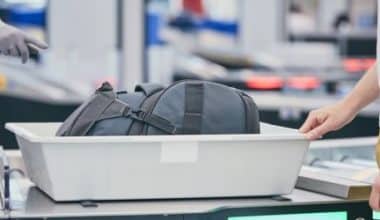The packing process can be one of the most nerve-wracking aspects of air travel, especially if you’re limited to just a carry-on bag or two. Whether you’re packing light on purpose or supplementing your checked luggage, it’s crucial to keep the Transportation Security Administration (TSA) carry-on luggage size standard in mind when packing a bag and heading to the airport.
After all, not all airlines provide free full-size carry-ons. Most have slightly different rules regarding the size of those bags. So to ensure you don’t get caught off guard at the airport, here’s everything you need to know about airlines and TSA carry-on size restrictions.
What Size is Carry-On Luggage: Overview
Airlines have their own methods for measuring luggage size to ensure that everything fits. (Unfortunately, the same cannot be said of economy class legroom.) Airlines measure your carry-on luggage in two ways.
- H x W x D: This formula is used by most airlines to calculate bag size. They may, for example, require dimensions such as 22 x 14 x 9 inches, which is the most common set of dimensions for carry-ons.
- Linear inches: Some airlines prefer a single number that sums all three dimensions (height, width, and depth). As long as the total dimensions of your bag do not exceed that magic number, you’re good to go!
Carry-On Luggage Regulations Vary by Airline
The dimensions of airline carry-on bags vary depending on the carrier. You’ll be able to see your carry-on and personal item limits when you book your flight.
A personal item is typically a small backpack, purse, briefcase, diaper bag, camera bag, or any item of comparable size that can fit beneath the seat in front of you. Carry-on luggage can range from a large backpack to a small rolling suitcase. However, size is more important than shape, so here are the carry-on luggage size restrictions for each of the major domestic airlines:
#1. Alaska Airlines Inc.
You can bring a carry-on and a personal item for free on an Alaska Airlines flight.
Carry-on bags are limited to 22 inches in length, 14 inches in width, and 9 inches in height (including wheels and handles). All three measurements should not exceed 45 inches.
Alaska provides examples of personal items such as a purse, laptop, or briefcase.
Although Alaska does not specify weight limits, it does state that passengers should be able to lift items that fit in an overhead bin.
#2. American Airlines Inc.
Passengers on an American Airlines flight receive one personal item and one carry-on regardless of fare type (elite members included).
Carry-on bags should not exceed 22 inches in length, 14 inches in width, and 9 inches in height, including handles and wheels.
Personal items should not be larger than 18 inches long, 14 inches wide, and 8 inches high.
Carry-on luggage has no weight restrictions.
#3. Delta Air Lines Inc.
Delta passengers are permitted to bring one carry-on bag and one personal item.
Measurements, including wheels and handles, must not exceed 22 inches long, 14 inches wide, and 9 inches high. The total length, width, and height of the baggage cannot exceed 45 linear inches.
For personal items, Delta suggests purses, small backpacks, and laptop computers.
Singapore (7 kg, about 15.4 pounds), Beijing (10 kg, about 22 pounds), and Shanghai (10 kg, about 22 pounds) all have weight restrictions.
#4. Frontier
Frontier charges for both checked luggage and carry-on bags, and the cost varies depending on the route flown. It also varies depending on whether you purchase the bags in advance via the web or mobile app, at the ticket counter, or at the boarding gate.
Carry-on bags must be less than 35 pounds in weight and no larger than 10 inches deep, 16 inches wide, and 24 inches high. Bags must be able to fit in the overhead bins.
Furthermore, they must be no longer than 62 linear inches (length + width + depth) and no heavier than 40 pounds. Bags weighing more than 40 pounds will be charged an additional fee per bag and direction. Bags weighing 41-50 pounds are $50 more, and bags weighing 51-100 pounds are $100 more.
Personal items cannot be deeper than 8 inches, wider than 18 inches, or higher than 14 inches.
#5. JetBlue
Not all JetBlue passengers are permitted to bring the same carry-on items. Passengers who purchased Basic Blue fares are entitled to one personal item (except Mosaic customers, who are always entitled to a carry-on). One carry-on and one personal item are permitted on Blue, Extra Blue, Blue Plus, and Mint fares.
The length, width, and height measurements, including wheels and handles, may not exceed 22 inches long, 14 inches wide, and 9 inches high.
Personal items must be 17 inches long, 13 inches wide, and 9 inches high or smaller in order to fit under the seat in front of you.
JetBlue has no weight restrictions for carry-on luggage.
#6. Southwest Airlines Inc.
Southwest is known for its generous free checked luggage allowance, but carry-on restrictions are comparable to those of most other airlines — one personal item and one carry-on per traveler.
Carry-on dimensions should not be more than 24 inches long, 16 inches wide, and 10 inches high.
Personal items are restricted to 18.5 inches in length, 8.5 inches in width, and 13.5 inches in height.
Southwest does not specify weight restrictions for carry-on items.
#7. United Airlines Inc.
Most United passengers can bring one carry-on and one personal item, but if you’re flying on a basic economy fare, you can only bring one personal item (unless you’re a MileagePlus Premier Member, traveling internationally, or have a MileagePlus credit card, such as the UnitedSM Business Card).
A carry-on’s maximum dimensions, including handles and wheels, are 22 inches long, 14 inches wide, and 9 inches high.
Personal items are restricted to 17 inches in length, 10 inches in width, and 9 inches in height.
United does not publish carry-on weight limits.
#8. Allegiant Airlines
Allegiant Air allows one free personal item (18 x 14 x 8 inches) that must fit under the seat. A larger carry-on (22 x 16 x 10 inches) is allowed, but there are fees that start at $28 when you book. The carry-on bag should not exceed 25 pounds.
Bag fees are an issue with Allegiant. In a hypothetical flight from Dulles Airport outside Washington, DC, to Austin, Texas, each carry-on costs $28 when booked, $45 if booked after purchasing your ticket but before departure, and $50 if checked at the airport. However, depending on where and when you travel, the fees can reach $70 per bag.
#9. Spirit Airlines Inc.
Spirit Airlines provides one free personal item (18 x 14 x 8 inches) but charges for larger carry-ons (22 x 18 x 10 inches), with fees starting at $59. The smaller carry-on must fit under the seat, while the larger carry-on must fit in the overhead bin.
Spirit’s fees, like those of most other low-cost carriers, rise as the date of travel approaches, peaking at $99 (!) if you pay for your carry-on at the airport.
#10. Sun Country Airlines, Inc.
Sun Country allows one personal item (17 x 13 x 9 inches) and one larger carry-on (24 x 16 x 11 inches) per passenger. The smaller carry-on must fit under the seat, while the larger carry-on must fit in the overhead bin. The carry-on bag should not exceed 35 pounds. Additional fees for larger carry-on bags begin at $30 when booking and increase to $50 per bag if paid at the gate.
Depending on the airline and the length of your trip, you may wonder whether it is better to travel with a checked bag rather than a carry-on. This is especially important if you have liquids with you that exceed the TSA's carry-on liquid limits.
TSA Liquid Restrictions
Before you can even get to your departure gate, you must pass through a TSA checkpoint. This means that you must follow the TSA liquid limit in order to pass through security.
How much weight is permitted on a plane?
Containers weighing 3.4 ounces or less are permitted, but there are additional guidelines to follow.
Limit on Carry-on Liquids
The TSA liquid rule, also known as the 3-1-1 rule (3 ounces, one bag per one person), is simple: “You are permitted to bring a quart-sized bag of liquids, aerosols, gels, creams, and pastes through the checkpoint in your carry-on bag.” These are limited to travel-sized containers weighing no more than 3.4 ounces (100 milliliters) per item.” Any liquids in larger containers must be checked (and are subject to overweight fees).
A basic clear, zip-top container qualifies as a quart-size bag for security clearance.
Hint: Start with containers no larger than 3.4 ounces (100 milliliters) and your quart-sized bag to manage the amount of fluids in your carry-on. The maximum size and amount of carry-on liquid depend on how much you can fit into your single quart-sized bag.
Exemptions From the 3-1-1 Liquids Rule
If you’re traveling with certain liquid medicines or baby food, the 3-1-1 liquid rule has a few exceptions.
Medication TSA allows “reasonable quantities” of certain medically necessary liquids, gels, and aerosols for your trip. The permitted amount is not specified.
The only snag? You must declare the medication to TSA officers at the checkpoint for inspection, along with any medication-related accessories, such as freezer packs or syringes.
Labeling your medical items can help speed up the screening process.
Breast milk and baby food formula are considered medically necessary liquids and thus exempt from the carry-on liquid limit. Water and juice for babies in quantities greater than 3.4 ounces (100 milliliters) are also permitted.
These items of child and infant nutrition are permitted in carry-on baggage and do not need to fit within a quart-sized bag. You may also bring gel- or liquid-filled teethers, as well as canned/jarred/processed baby food, in your carry-on luggage.
Duty-Free Liquids
The final TSA liquid limit exemption applies to duty-free liquids purchased on inbound international flights. It is critical that these bags are secure, temperature visible, and stored in a clear bag.
Other TSA Carry-On Regulations
Flammables
Cigarettes, cigarettes, disposable and Zippo lighters, and dry batteries (such as AAs or AAAs) are the only flammables permitted in a carry-on.
Camping and sporting goods
You can bring an air mattress with a built-in pump, antlers, basketballs, footballs, baseballs, soccer balls, bike chains, and bike pumps (with special instructions). Baseball bats, bear spray, and bear bangers, as well as an aerosol insecticide, are not permitted on any airline.
Other things
Knives, firearms, and box cutters are among the prohibited items. A complete list can be found on the TSA’s website.
Nerdy Hint
Still not sure if something you want to bring with you is prohibited? To find out, send a photo to AskTSA on Twitter or Facebook Messenger.
Final Thoughts
No matter which airline you fly with, make sure you know what size carry-on you can bring onboard and are familiar with (and ready for) the TSA’s carry-on restrictions. Then you can look forward to a less stressful airport and airliner experience.
What Constitutes Carry-On Luggage?
There are no standard sizes for carry-on luggage, with each airline imposing its own size and weight limits. If you want to buy a carry-on bag that most airlines will accept, the most common maximum size is 56 x 36 x 23 cm (22 x 14 x 9 inches) (including all handles and wheels).
What is the best carry-on luggage?
The best carry-on bag will be determined by your specific needs, such as whether you need a wheelie case or a backpack or a bag with a laptop compartment or built-in security. From soft and hard shell wheelies to convenient backpacks, we’ve highlighted the best carry-on luggage bags for any traveler.
Is a backpack a carry-on item?
A backpack is considered a carry-on item if it fits within the maximum size restrictions of a particular airline. Most airlines allow for a larger standard carry-on piece and a slightly smaller personal item (where permitted).
What items are not permitted in a carry-on bag?
Certain items are prohibited for carry-on luggage for safety reasons. Individual liquids weighing more than 100 mL (3.4 oz) or a combined allowance of more than 1 liter (1 quart), sharp objects such as scissors, blades, or pen knives, firearms, sporting equipment such as baseball bats or hockey sticks, tools, lighters, matches, or other flammable items are all prohibited.
Is there a limit to the weight of carry-on luggage?
There are no maximum weight allowances for carry-on luggage, as there are size restrictions. Each airline defines these, with some not stating a restriction at all — just that you must be able to lift the bag into the overhead compartment yourself.
It’s also worth double-checking whether the airline’s stated weight allowance applies only to your carry-on or to both your carry-on and personal item (if applicable).
What’s the distinction between a personal item and a carry-on?
In addition to a carry-on bag, many airlines allow passengers to bring personal items. A personal item is typically a smaller bag, such as a handbag, briefcase, or laptop bag, that can be stored beneath the seat in front of you. Some airlines specify size and weight limits for personal items, while others do not.
What Size Is Carry-On Luggage: Related Articles
- UNITED AIRLINES LOGO: Meaning, History, and Why the Logo Was Changed
- How to Calculate Chargeable Weight?
- Tax Sheltered Annuity (TSA): 403 (b) Plans and Guidelines
- CAN YOU FLY WITH AN EXPIRED ID? TSA Requirements For Flying
- 15 TOP RATED LUGGAGE IN 2023






